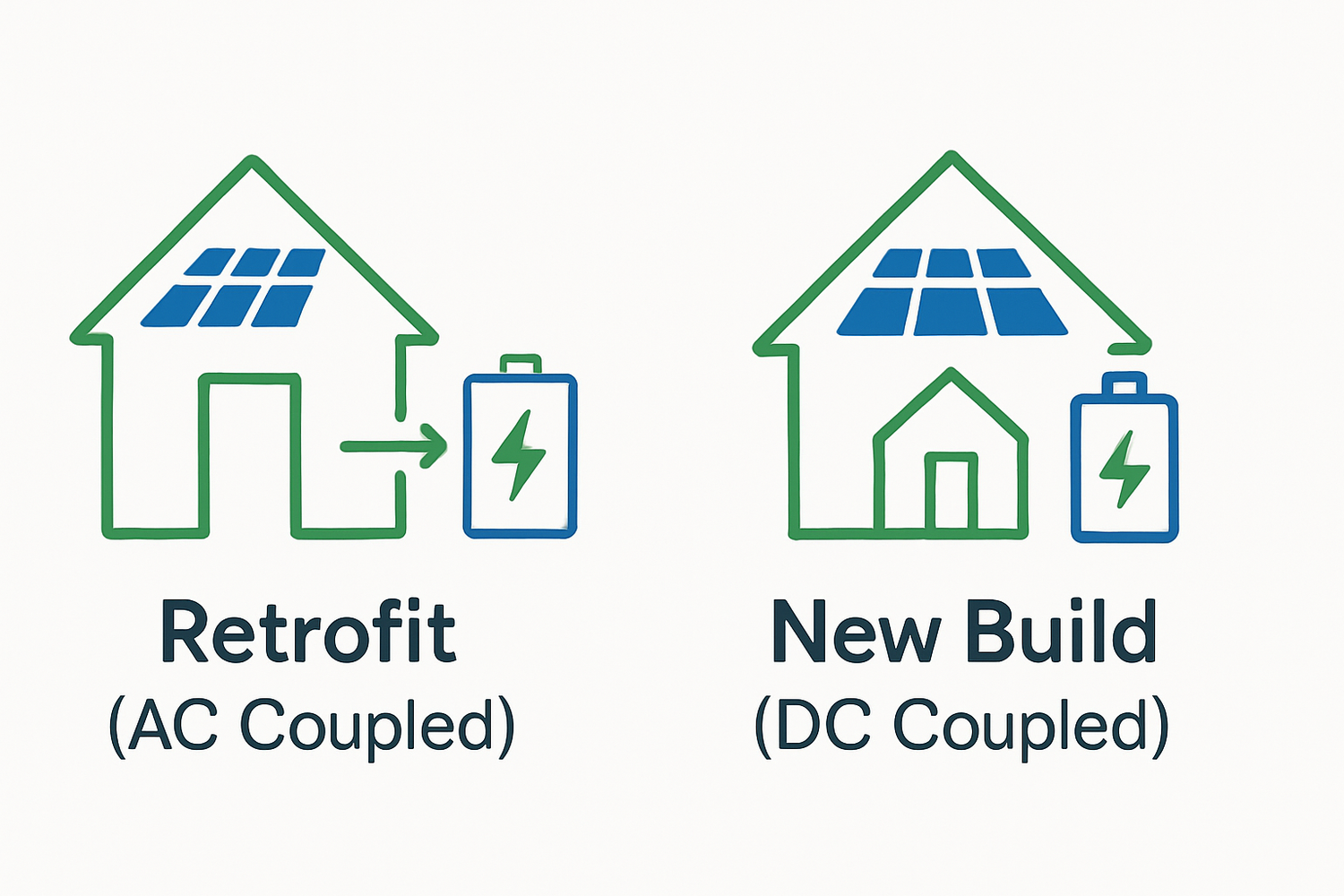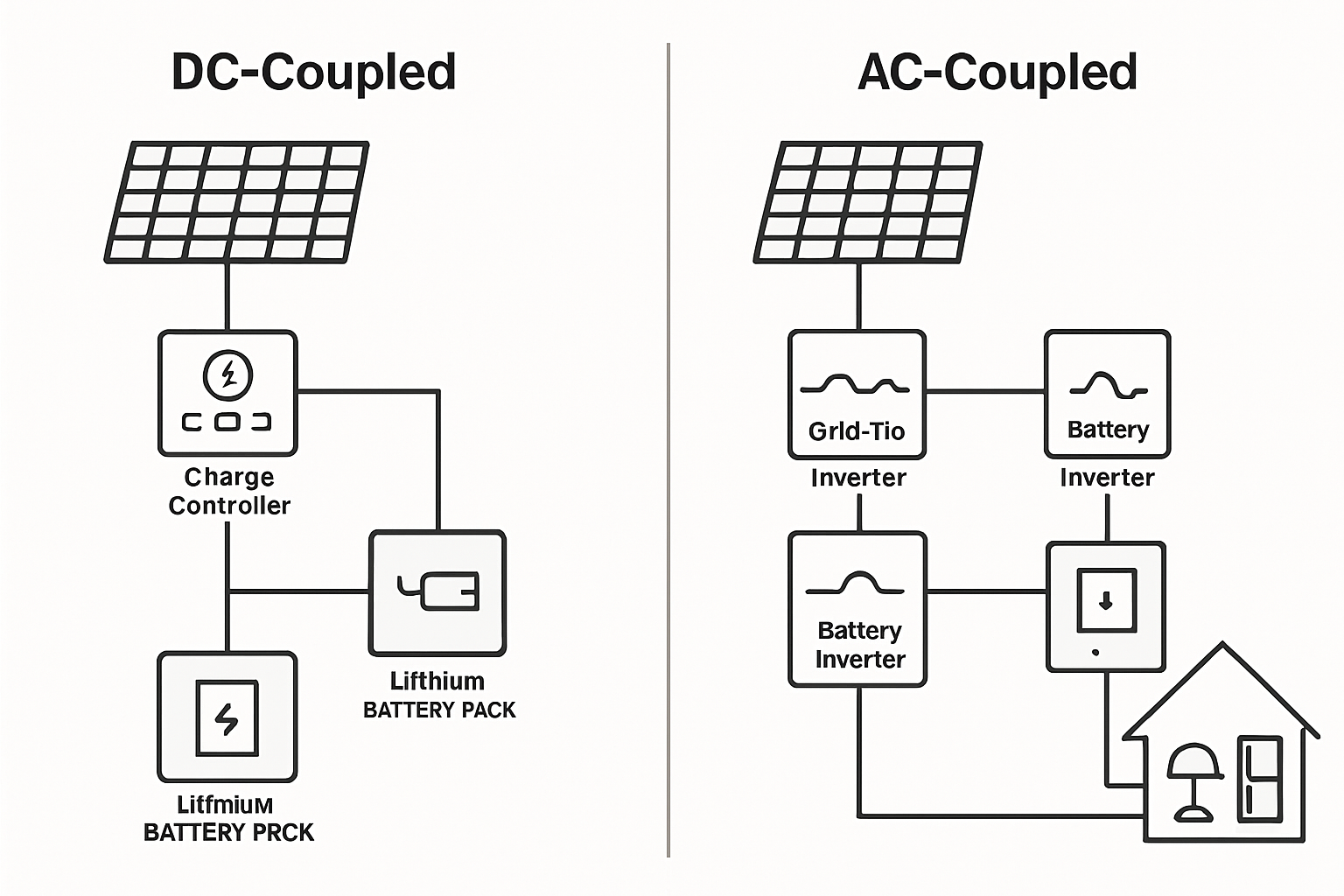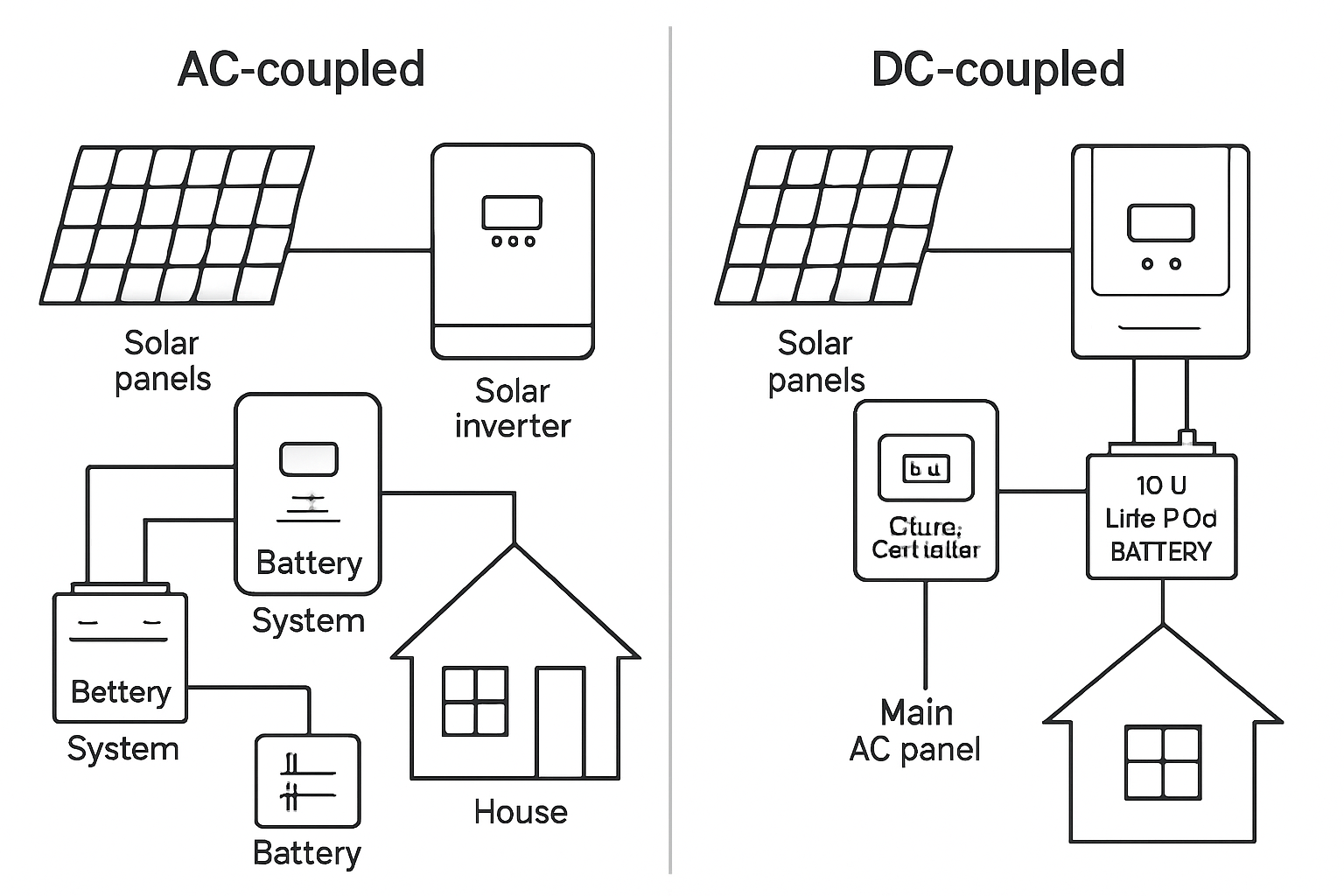Adding a solar energy storage system is a significant step toward energy independence. The big question is whether to add a battery to your existing solar panels—a retrofit—or install a completely new, integrated system. This decision often comes down to understanding the core technologies that connect your panels to a battery: AC coupling and DC coupling. Each path has distinct advantages depending on your current setup and future energy goals.
Understanding the Core Technologies: AC vs. DC Coupling
The choice between retrofitting and a new build is fundamentally linked to how your battery connects to your solar array. Solar panels produce direct current (DC) electricity, while your home uses alternating current (AC). Batteries, like solar panels, store energy as DC. The method of converting and directing this power defines the system's architecture and performance.
What is a DC-Coupled System?
In a DC-coupled system, the DC power from your solar panels flows through a charge controller directly to your battery. When your home needs power, the stored DC energy is sent to a single hybrid inverter, which converts it to AC electricity for your appliances. This streamlined path involves only one DC-to-AC conversion, making it highly efficient. DC-coupled systems are the standard for new solar battery installations because they integrate all components for optimal performance from the start.
What is an AC-Coupled System?
An AC-coupled system is designed to work with an existing solar panel installation. The DC power from your panels first goes to your existing solar inverter, which converts it to AC power for your home. To add a battery, a second inverter—a battery inverter—is installed. This inverter takes the AC power, converts it back to DC to charge the battery, and then converts it back to AC again when your home needs to draw from the battery. This setup offers great flexibility, making it the go-to choice for retrofitting.
The Retrofit Route: Adding Storage to Your Existing Solar Panels
If you already have a solar panel system, retrofitting with an AC-coupled battery is often the most practical and cost-effective way to add storage.
Key Advantages of Retrofitting
The primary benefit of retrofitting is its modularity. You can add a lithium battery storage solution without altering your existing solar installation. This approach allows you to work with different manufacturers for your battery and inverter, giving you more product choices. Installation is often simpler because the battery system connects directly to your home's main electrical panel, functioning independently of the solar array.
Potential Challenges and Considerations
The main drawback of AC-coupling is lower round-trip efficiency. Power is converted multiple times (DC to AC, then AC to DC, and back to AC), leading to energy losses at each step. While a DC-coupled system can achieve over 95% efficiency, an AC-coupled system's efficiency is typically around 90%. Compatibility can also be a concern, as the new battery system must integrate with your existing electrical setup. It's also important to verify how adding a third-party battery might affect your original solar system's warranty.
The New Build Approach: An Integrated System from Day One
For those new to solar or planning a complete system overhaul, a new build with a DC-coupled battery offers a seamless and highly efficient solution.
Benefits of a New, Integrated System
Efficiency is the standout advantage of a new, DC-coupled system. With fewer energy conversions, more of the solar power you generate is stored and used. This can lead to greater long-term savings. A new build ensures all components, from the 12v 100ah lifepo4 lithium battery to the hybrid inverter, are designed to work together perfectly. This integration simplifies installation and means you are covered by a single manufacturer's warranty for the entire energy storage system.
Cost and Installation Factors
The upfront cost of a new, integrated system is higher than a simple battery retrofit because you are purchasing all components at once. However, the installation can be more straightforward with fewer components to wire. According to the U.S. Department of Energy, combining solar and storage can provide resilience and improve power quality by matching energy supply with demand. This long-term value often justifies the initial investment.
A Data-Driven Comparison: Performance and Costs
Choosing between a retrofit and a new build depends on your specific situation. The International Energy Agency (IEA) notes that the combination of solar PV and batteries is becoming increasingly competitive. Here’s a table to help compare the two approaches.
| Feature | Retrofit (AC-Coupled) | New Build (DC-Coupled) |
|---|---|---|
| Round-Trip Efficiency | Approx. 90% | Up to 97.5% |
| Installation Complexity | Lower (if compatible) | Higher (integrated system) |
| Upfront Cost | Lower (battery and inverter only) | Higher (full system cost) |
| Scalability | Highly flexible, easy to expand | Dependent on hybrid inverter capacity |
| Ideal Use Case | Adding storage to an existing solar system | New solar installations or major system upgrades |
For a deeper dive into system performance, the Ultimate Reference for Solar Storage Performance provides valuable metrics on how different setups perform under real-world conditions.
Making Your Final Decision
Ultimately, the best solar energy storage solution aligns with your needs, budget, and existing infrastructure. If you have a functional solar array, retrofitting with an AC-coupled battery is a logical and efficient upgrade. If you are starting from scratch or your current system is outdated, a new, integrated DC-coupled system will deliver superior efficiency and long-term value. The U.S. Energy Information Administration (EIA) reports a significant increase in residential solar installations being paired with battery storage, underscoring the growing trend toward integrated solutions. As you plan, consider your long-term energy goals and consult with a qualified installer to design a system that helps you achieve them.
Disclaimer: This article provides general information and is not intended as financial or legal advice. Please consult with a professional for guidance specific to your situation.
Frequently Asked Questions
Can any solar panel system be retrofitted with a battery?
Most existing grid-tied solar systems can be retrofitted with an AC-coupled battery. The flexibility of AC coupling allows the battery system to be installed independently of the solar inverter. However, it's crucial to have a professional assess your current electrical panel and system components to ensure compatibility.
How does round-trip efficiency affect my savings?
Round-trip efficiency measures how much usable energy you get out of a battery compared to the amount put in. A higher efficiency means less energy is lost during charging and discharging. A DC-coupled system with 95% efficiency will deliver 9.5 kWh of usable energy for every 10 kWh stored, while an AC-coupled system at 90% would deliver 9.0 kWh. Over time, this small difference can add up to noticeable savings on your energy bills.
Will adding a battery void my existing solar system's warranty?
It depends on the manufacturer and installer of your original system. Adding an AC-coupled battery from a different provider generally shouldn't void your solar panel warranty because it doesn't modify the existing PV installation. However, some companies may have specific clauses. Always review your warranty documents and discuss the addition with your original installer to avoid any potential issues.





Leave a comment
All comments are moderated before being published.
This site is protected by hCaptcha and the hCaptcha Privacy Policy and Terms of Service apply.